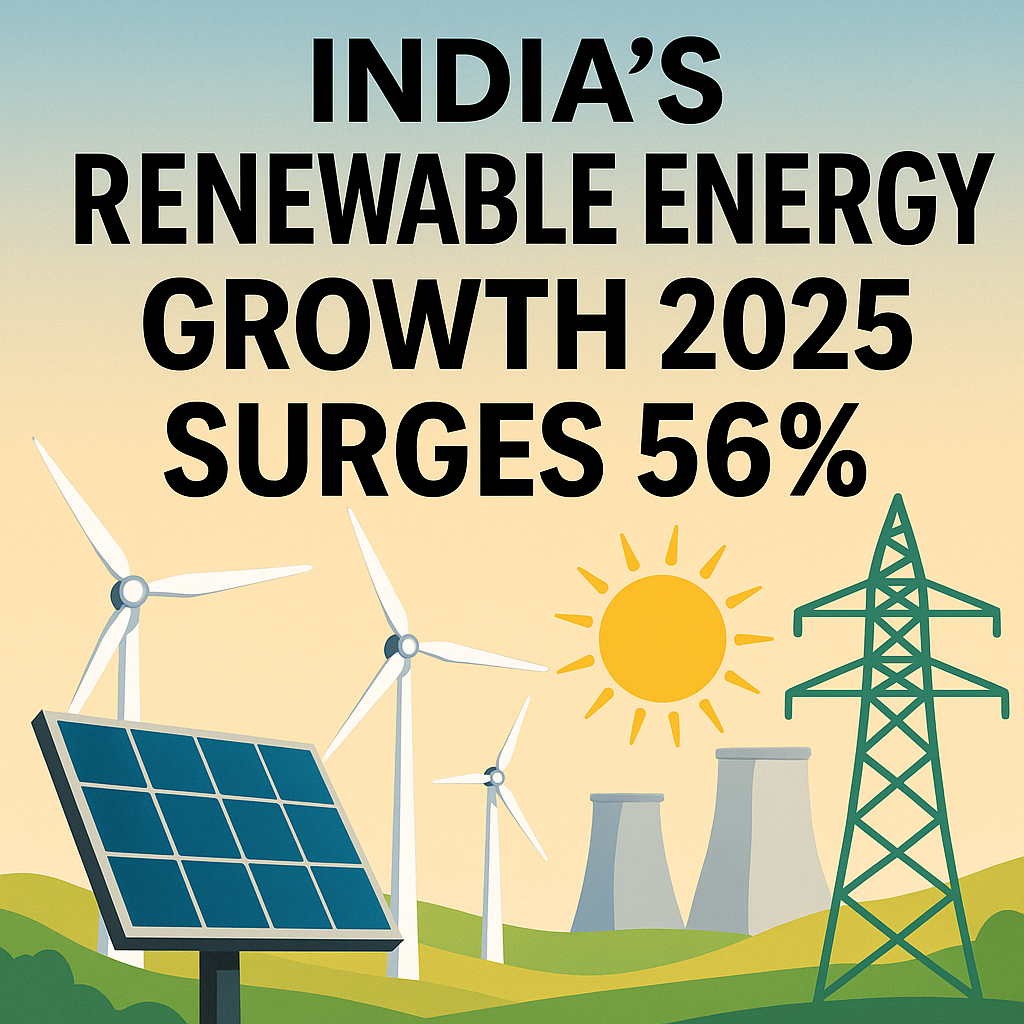India is setting a new benchmark in the global clean and renewable energy landscape. During the first six months of 2025, the country added a record-breaking 22 gigawatts (GW) of renewable energy capacity, a staggering 56% increase compared to the same period last year. This surge is more than a numerical feat; it signals a paradigm shift in India’s energy mix. With clean energy now surpassing fossil fuel capacity, India is positioning itself as a formidable leader in sustainable power generation.
India’s Renewable Energy Growth 2025: A Record-Breaking First Half

According to data from the Central Electricity Authority (CEA), India’s renewable energy additions in the first half of 2025 reached unprecedented levels. The 22 GW installed exceeds the 14.1 GW added during the same period in 2024, showing a consistent upward trajectory. This momentum is fueled by robust policy frameworks, private sector investments, and a favorable global economic environment for renewable technologies. It highlights the growing maturity of India’s clean energy market and the country’s unwavering focus on sustainable development.
Why the Surge Matters: Clean Energy vs Fossil Fuels
In a landmark development, India’s total installed capacity from non-fossil sources, including solar, wind, large hydro, and nuclear, has overtaken fossil fuel-based capacity. This is a critical inflection point that underscores a transition in India’s energy priorities. Beyond its symbolic significance, the shift enhances energy security, reduces exposure to global fossil fuel price volatility, and aligns India with global efforts to combat climate change. It also reflects an improved investment climate for renewable infrastructure and green technology.
Path to 2030: Can India Hit 500 GW of Non-Fossil Capacity?
India’s official commitment to install 500 GW of non-fossil capacity by 2030 once drew skepticism due to sluggish progress in earlier years. However, the 2025 growth spurt brings renewed optimism. If this pace continues and systemic hurdles are addressed, the target appears increasingly attainable. Success will depend on the ability to replicate and scale recent growth across all renewable sectors while simultaneously managing regulatory, logistical, and financial bottlenecks. A consistent policy push and diversified investments are vital for long-term achievement.
Hydro, Nuclear, Solar, and Wind: What’s Driving the Boom?
India’s clean energy acceleration is the result of synergistic growth across multiple segments. Solar remains the front-runner, accounting for a significant portion of the new installations, particularly from utility-scale projects in states like Rajasthan, Gujarat, and Karnataka. Wind energy has also gained momentum, supported by high wind potential zones and attractive tariffs. Large hydro projects add grid stability and peaking power, while nuclear energy, though smaller in scale, continues to provide reliable base-load electricity. Each source plays a strategic role in diversifying and stabilizing the energy mix.
Coal Still Dominates Power Generation
Despite the notable shift in installed capacity, coal remains the dominant source of electricity generation in India, accounting for nearly three-quarters of the country’s power. The reason lies in coal’s reliability and the scale of existing infrastructure. As India grapples with rising electricity demand driven by urbanization and industrial growth, coal remains a key fallback. New coal plants are still under development to ensure energy availability. This dual-track approach, which expands renewables while maintaining coal, reflects the complex energy needs of a rapidly growing economy.
Challenges Ahead: The Need for Energy Storage and Grid Upgrades
India’s renewable success story faces a major hurdle: integration. Solar and wind energy are variable, depending on weather and time of day, which challenges grid stability. To overcome this, large-scale energy storage systems like lithium-ion batteries and pumped hydro are essential. Additionally, the national grid needs significant modernization to handle increased and decentralized power inflows. Investments in smart grid technologies, flexible transmission systems, and regional interconnectivity are critical. Without addressing these infrastructure gaps, the full benefits of renewable capacity additions may not materialize.
Expert Insight: Is India Undergoing a True Energy Transition?
While renewable energy growth is accelerating, experts caution that India is not yet undergoing a complete energy transition. Sushma Jagannath, Vice-President for Renewables and Power at Rystad Energy, emphasized that without urgent upgrades to grid infrastructure and large-scale deployment of energy storage, coal will continue to play a central role. Her assessment points to a deeper issue: generating renewable power is just one piece of the puzzle. A holistic transformation requires integration, transmission, distribution, and demand-side reforms to truly wean India off fossil fuels.
What This Means for India’s Net Zero Goals
India’s commitment to achieving net zero emissions by 2070 is a long-term strategy that hinges on consistent progress in decarbonization. The surge in renewable installations during 2025 is a significant step forward. However, reaching net zero involves more than just expanding capacity. It requires a fundamental shift in how energy is produced, consumed, and stored. From electrifying transport and greening industries to reforming agricultural practices and promoting energy efficiency, the road to net zero is complex but increasingly within reach. The 2025 gains form a strong foundation upon which India can build a sustainable, low-carbon future.
Reference: Economics Times, Thomson Reuters
Also Read: India Ranks Third Globally in Power Generation Growth, Driven by Clean Energy Push: IEA Report
